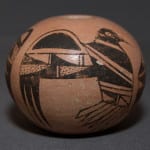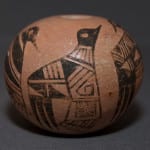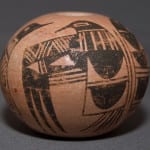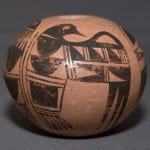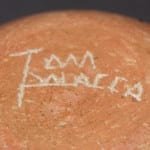The black paint has not adhered well, so there is some lightening of the design. The tan unpainted surface of the pot has small white blotches (specks?) and is not “blushed” like much Hopi-Tewa pottery. His signature is engraved into the bottom of the pot, revealing a white clay body, apparently covered with a thin slip that fires tan. It may be that the white blotches are the underbody showing through where the slip did not adhere. The pot is thick and heavy for its size. It may be kiln-fired; it’s hard to tell.
For all these imperfections, the design of the four birds is imaginative, carefully composed and expertly drawn. The heads of two birds are turned so they look in opposite directions over outstretched wings held at right angle to the body. Of the remaining two birds, one has an outstretched wing but is looking away from it. The final bird is different than the other three: its wing is folded down and its head is pointing up. The design motifs that form the wing and body are unique to each bird. The overall design is graceful and energized; the design fits the pot perfectly. One imagines a flock of birds resting and stretching after a long flight while they gab about their adventures. The pot has an oriental delicacy of design, or maybe folk art sweetness. Or maybe both.
The design elements are fairly usual on a Hopi pot, but there are used here to create a design that is not typical. The other Thomas Polacca pot in the collection (2005-09) uses techniques and design that are closer to Santa Clara pueblo than Hopi. Later in his career Tom Polacca became famous for thick-walled pots that were carved like (and with representations of) katchinas. Traditionalist that I am, I am not particularly drawn to these carved pots, though I recognize the skill needed to create them. Given the fineness of the design of seedpot 2009-18, I imagine what other wonderful pots Tom Polacca would have created had he stayed with more traditional Sikyatki Revival techniques.
Since it is not signed using the family name “Nampeyo,” the jar 2009-18 was probably made after 1988.



